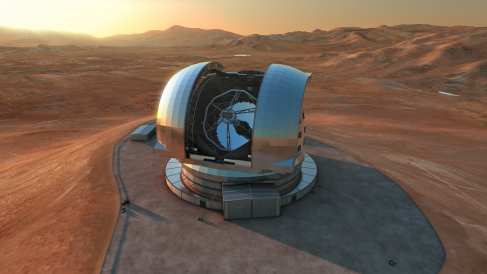| << Chapter < Page | Chapter >> Page > |
The most ambitious of these projects is the European Extremely Large Telescope (E-ELT) ( [link] ). (Astronomers try to outdo each other not only with the size of these telescopes, but also their names!) The design of the E-ELT calls for a 39.3-meter primary mirror, which will follow the Keck design and be made up of 798 hexagonal mirrors, each 1.4 meters in diameter and all held precisely in position so that they form a continuous surface.
Construction on the site in the Atacama Desert in Northern Chile started in 2014. The E-ELT, along with the Thirty Meter Telescope and the Giant Magellan Telescope, which are being built by international consortia led by US astronomers, will combine light-gathering power with high-resolution imaging. These powerful new instruments will enable astronomers to tackle many important astronomical problems. For example, they should be able to tell us when, where, and how often planets form around other stars. They should even be able to provide us images and spectra of such planets and thus, perhaps, give us the first real evidence (from the chemistry of these planets’ atmospheres) that life exists elsewhere.

Check out this fun diagram comparing the sizes of the largest planned and existing telescopes to a regulation basketball and tennis court.
New and even larger telescopes are on the drawing boards. The James Webb Space Telescope, a 6-meter successor to Hubble, is currently scheduled for launch in 2018. Gamma-ray astronomers are planning to build the CTA to measure very energetic gamma rays. Astronomers are building the LSST to observe with an unprecedented field of view and a new generation of visible-light/infrared telescopes with apertures of 24.5 to 39 meters in diameter.
Blades, J. C. “Fixing the Hubble One Last Time.” Sky&Telescope (October 2008): 26. On the last Shuttle service mission and what the Hubble was then capable of doing.
Brown, A. “How Gaia will Map a Billion Stars.” Astronomy (December 2014): 32. Nice review of the mission to do photometry and spectroscopy of all stars above a certain brightness.
Irion, R. “Prime Time.” Astronomy (February 2001): 46. On how time is allotted on the major research telescopes.
Jedicke, Peter&Robert. “The Coming Giant Sky Patrols.” Sky&Telescope (September 2008): 30. About giant telescopes to survey the sky continuously.
Lazio, Joseph, et al. “Tuning in to the Universe: 21 st Century Radio Astronomy.” Sky&Telescope (July 2008): 21. About ALMA and the Square Kilometer Array.
Lowe, Jonathan. “Mirror, Mirror.” Sky&Telescope (December 2007): 22. On the Large Binocular Telescope in Arizona.
Lowe, Jonathan. “Next Light: Tomorrow’s Monster Telescopes.” Sky&Telescope (April 2008): 20. About plans for extremely large telescopes on the ground.
Mason, Todd&Robin. “Palomar’s Big Eye.” Sky&Telescope (December 2008): 36. On the Hale 200-inch telescope.

Notification Switch
Would you like to follow the 'Astronomy' conversation and receive update notifications?